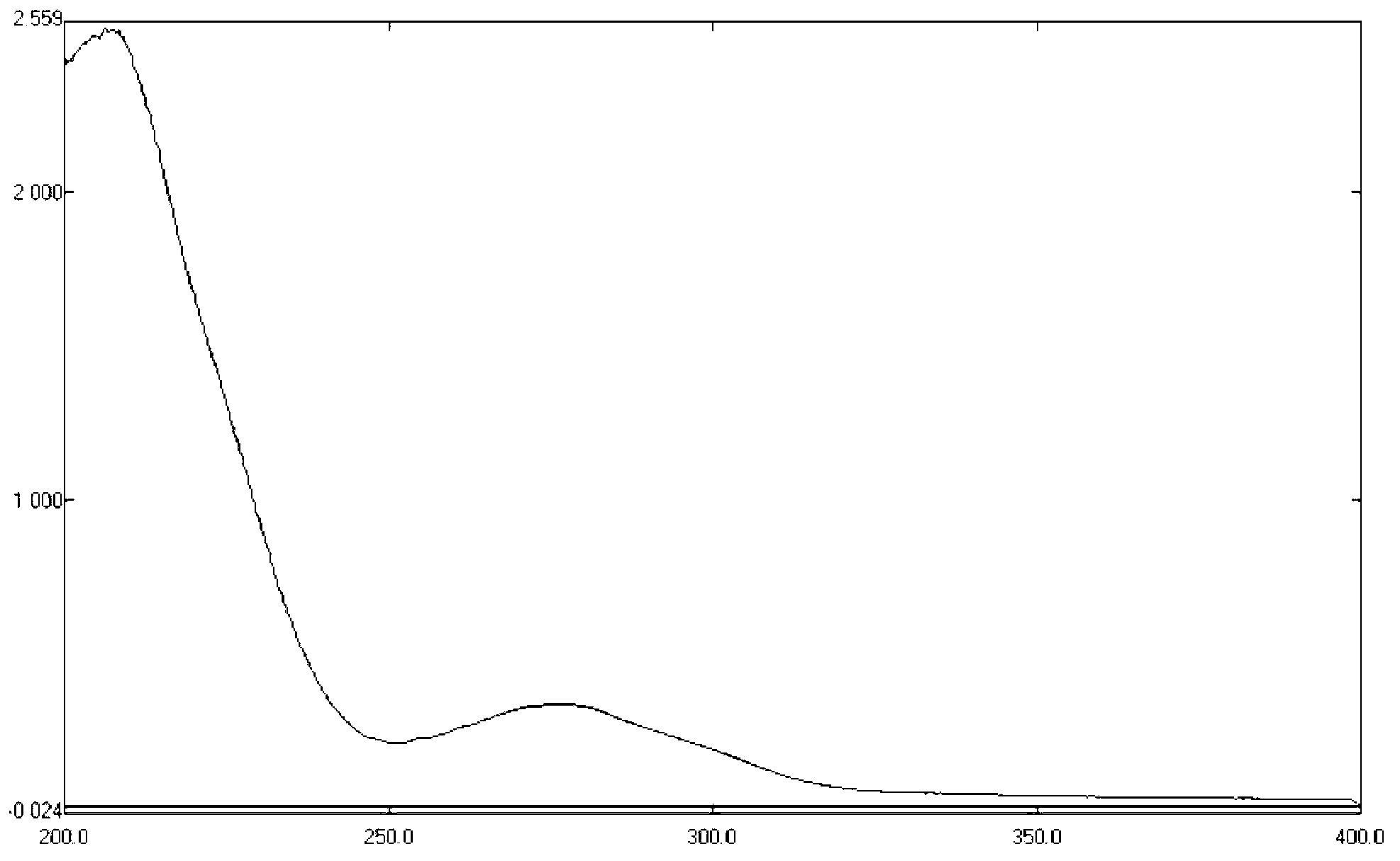Method for determining fat soluble green tea polyphenol content
A technology of fat-soluble tea polyphenols and tea polyphenols, applied in the direction of color/spectral characteristic measurement, etc., can solve the problems of inaccurate determination of fat-soluble tea polyphenols content, etc., achieve simple and feasible measurement methods, reduce costs, and be easy to popularize and apply Effect
- Summary
- Abstract
- Description
- Claims
- Application Information
AI Technical Summary
Problems solved by technology
Method used
Image
Examples
Embodiment 1
[0071] When tea polyphenol is used as raw material, and the acylating agent is stearic acid halide or stearic anhydride, the fat-soluble tea polyphenol is tea polyphenol stearate, and the content of tea polyphenol stearate is determined.
[0072] The reference substance is tea polyphenol stearate, and its ultraviolet wavelength scanning diagram of tea polyphenol stearate is shown in Figure 2.
[0073] According to the maximum absorption wavelength of the reference substance solution and the test solution is 275nm, then it is determined that the detection wavelength is 275nm and the error is ± 2nm, that is, the detection is effective within the 275nm error of ± 2nm.
[0074] Take 50 mg of dry tea polyphenol stearate, dissolve it with absolute ethanol and make it up to 100 mL, take 0, 2, 4, 6, 8 and 10 mL of the solution respectively in a 50 mL volumetric flask, and make it up to volume with absolute ethanol , to obtain the reference substance solution containing 0, 20, 40, 60, ...
Embodiment 2
[0078] When tea polyphenol is used as raw material, and the acylating agent is stearic acid halide or stearic anhydride, the fat-soluble tea polyphenol is tea polyphenol stearate, and the content of tea polyphenol stearate raw material is determined.
[0079] According to the maximum absorption wavelength of the reference substance solution and the test solution is 275nm, then it is determined that the detection wavelength is 275nm and the error is ± 2nm, that is, the detection is effective within the 275nm error of ± 2nm.
[0080]The reference substance is epigallocatechin gallate stearate, which is the reaction product of epigallocatechin gallate contained in tea polyphenols and stearic acid halide or stearic anhydride. The ultraviolet wavelength scanning picture of vegetarian gallate stearate is as follows image 3 shown.
[0081] Get dry epigallocatechin gallate stearate, dissolve with organic solvent, be mixed with every milliliter containing epigallocatechin gallate ste...
Embodiment 3
[0085] When tea polyphenols are used as raw materials and the acylating agent is palmitic acid halide or palmitic anhydride, the fat-soluble tea polyphenol is tea polyphenol palmitate, and the content of the preparation of tea polyphenol palmitate is determined, specifically for the determination Content of tea polyphenol palmitate gel.
[0086] The reference substance is epigallocatechin gallate palmitate, which is the reaction product of epigallocatechin gallate contained in tea polyphenols and palmitic acid halide or palmitic anhydride.
[0087] According to the maximum absorption wavelength of the reference substance solution and the test solution is 275nm, then it is determined that the detection wavelength is 275nm and the error is ± 2nm, that is, the detection is effective in the 275nm error within the wavelength range of ± 2nm.
[0088] Take the dried epigallocatechin gallate palmitate, dissolve it with an organic solvent, and prepare the preparations containing 0, 20,...
PUM
 Login to View More
Login to View More Abstract
Description
Claims
Application Information
 Login to View More
Login to View More - R&D
- Intellectual Property
- Life Sciences
- Materials
- Tech Scout
- Unparalleled Data Quality
- Higher Quality Content
- 60% Fewer Hallucinations
Browse by: Latest US Patents, China's latest patents, Technical Efficacy Thesaurus, Application Domain, Technology Topic, Popular Technical Reports.
© 2025 PatSnap. All rights reserved.Legal|Privacy policy|Modern Slavery Act Transparency Statement|Sitemap|About US| Contact US: help@patsnap.com



